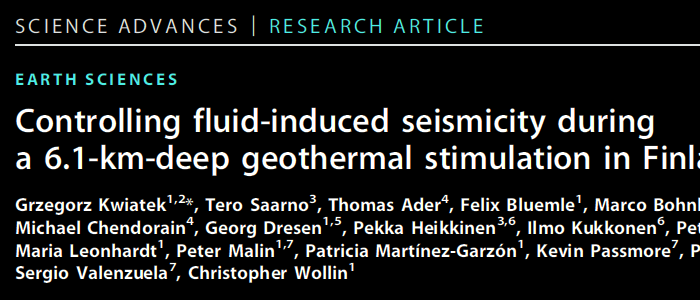Finally, our new paper “Controlling fluid-induced seismicity during a 6.1-km-deep geothermal stimulation in Finland”, published on May 1st in Science Advances, is out!
In the study we report on a successful attempt to control induced seismicity during the deepest-ever hydraulic stimulation of a geothermal well in Helsinki, Finland. In a collaborative effort by a team of international researchers from commercial companies, academic institutions and universities, a safe stimulation strategy was designed and successfully applied preventing the occurrence of a project-stopping induced earthquake with a magnitude larger than 2.0, a limit imposed by local authorities for the safe continuation of the St1 Deep Heat Oy energy project. In the project, a traffic-light-style system involving near-realtime seismic monitoring allowed active feedback and guidelines to the stimulation engineers on how to adjust pumping rates and pressure at the injection. This feedback in near real-time was the key to success and allowed to deepen the understanding of the reservoir seismic response and the hydraulic energy release at depth, while ensuring promptness in the technical response to increased seismic activity. This allowed immediate adjustment of the reservoir treatment through mitigating injection-rate and duration of resting periods that were applied in the course of the months-long experiment and ensured the successful control of maximum observed magnitude of the induced seismic events.
You can download the manuscript from Science Advances website.
The reference:
Kwiatek, G., T. Saarno, T. Ader, F. Bluemle, M. Bohnhoff, M. Chendorain, G. Dresen,
P. Heikkinen, I. Kukkonen, P. Leary, M. Leonhardt, P. Malin, P. Martínez-Garzón, K. Passmore, P. Passmore, S. Valenzuela, and C. Wollin (2019). Controlling fluid-induced seismicity during a 6.1-km-deep geothermal stimulation in Finland, Sci Adv 5, no. 5, eaav7224, doi 10.1126/sciadv.aav7224. [ Article Page ]
